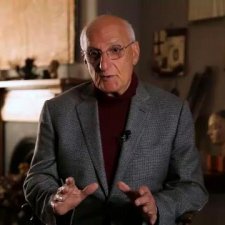Shane Maloney (b. 1953), author, studied Asian history and politics at ANU and held an assortment of jobs before embarking on what was to become Australia’s most successful crime novel series: Stiff (1994), The Brush-Off (1996), Nice Try (1998), The Big Ask (2000), Something Fishy (2002) and Sucked In (2007). Stiff and The Brush Off were adapted for television by John Clarke in 2004; David Wenham starred as Maloney’s fictional protagonist, state Labor MP Murray Whelan. Maloney is also co-author of The Happy Phrase: Everyday conversation made easy (2004) and writes a regular column, ‘Encounters’, for the intellectual journal The Monthly.
Rick Amor portrayed Shane Maloney near the railway lines in inner-city Melbourne. Once, Maloney recalls, there was a road over Downie Street where Flinders Street flew across King Street and down to Spencer Street. Now demolished, it was characteristic of that part of Melbourne, where industrial buildings such as those suggested in the painting are now being refurbished and repurposed. The portrait is something like a painting based on a dream of meeting a wordless Maloney in a half-familiar location.
Collection: National Portrait Gallery
Gift of the artist 2010
Donated through the Australian Government's Cultural Gifts Program
© Rick Amor/Copyright Agency, 2024
The portrait is titled The Crime Writer Shane Maloney and was painted by Rick Amor in 2004. It is oil on canvas, measuring approximately 1.6m tall by 2m wide. The painting sits suspended within its dark wood ‘floating frame’; this illusion created by a narrow gap between the edge of the canvas and frame. Shane is shown as a small figure, gazing towards us, feet apart. He stands in the middle of the road, towards the end of a dingy laneway of tall, shadowy buildings. In the background, a further road cuts across, making a ‘T’ intersection; there is a bare, solitary tree, graffitied concrete wall, and a patch of pale sky.
On the left of the portrait, taking up a third of the image is part of a huge, warm-grey building. On the first floor are three vast windowpanes, revealing a dim, cavernous interior; a few weak lights dotting its towering ceiling. A bald, hunched figure in a white shirt, back turned to us, sits amidst the darkness.
Beneath the window, at street level, the building appears to be constructed from large stone blocks. Their flat surfaces and geometric lines are broken by a substantial curved carving set into them. Tight, next to the building is a small square of ground; a tree with a smooth trunk, leans slightly away from it, towards the sky; its spindly branches reaching up and out. Partly obscured by the tree, a man, head lowered, in a grey suit walks towards the left of the painting.
In the centre of the image, high above Shane, is a rectangular opening of sky; soft grey-blue at the very top edge of the painting, gradually turning to a pale peach. The sky is interrupted by two tall, slender, motorway lampposts and a metal rail, perched on a slightly angled concrete retaining wall; stained, and marked with graffiti.
On the right of the laneway a traffic sign stands beside another looming building. Painted on its wall in red is the number seven, above it is an arrow, pointing towards a large, deep-reddish, opening. The paving beneath slopes downwards into the dark.
Shane stands in the middle of the laneway, framed by stone or concrete on all sides, and the window of sky above. His light brown hair is parted on the side and combed back from his face. Light reflects off the smooth, pale skin of his high, domed forehead, and face. Shane looks directly at us with grey-brown eyes, through round, fine-rimmed glasses. His lips are pursed and turn down at the edges.
Shane is dressed in loose, casual clothes. He has a navy collared shirt under an open jacket the same colour. His arms hang by his sides; fingers on his left hand slightly curling, right hand closed. Shane’s trousers are an olive-beige, shoes, dark brown, blending in with the concrete and shadows of the laneway.
Audio description written by Lucinda Shawcross and voiced by Emma Bedford
Rick Amor (21 portraits)



On one level The Companion talks about the most famous and frontline Australians, but on another it tells us about ourselves.



Australian author David Malouf discusses the creation of his portrait by artist Rick Amor.



Artist Rick Amor and author Shane Maloney relate divergent experiences of the creation of Shane's portrait.